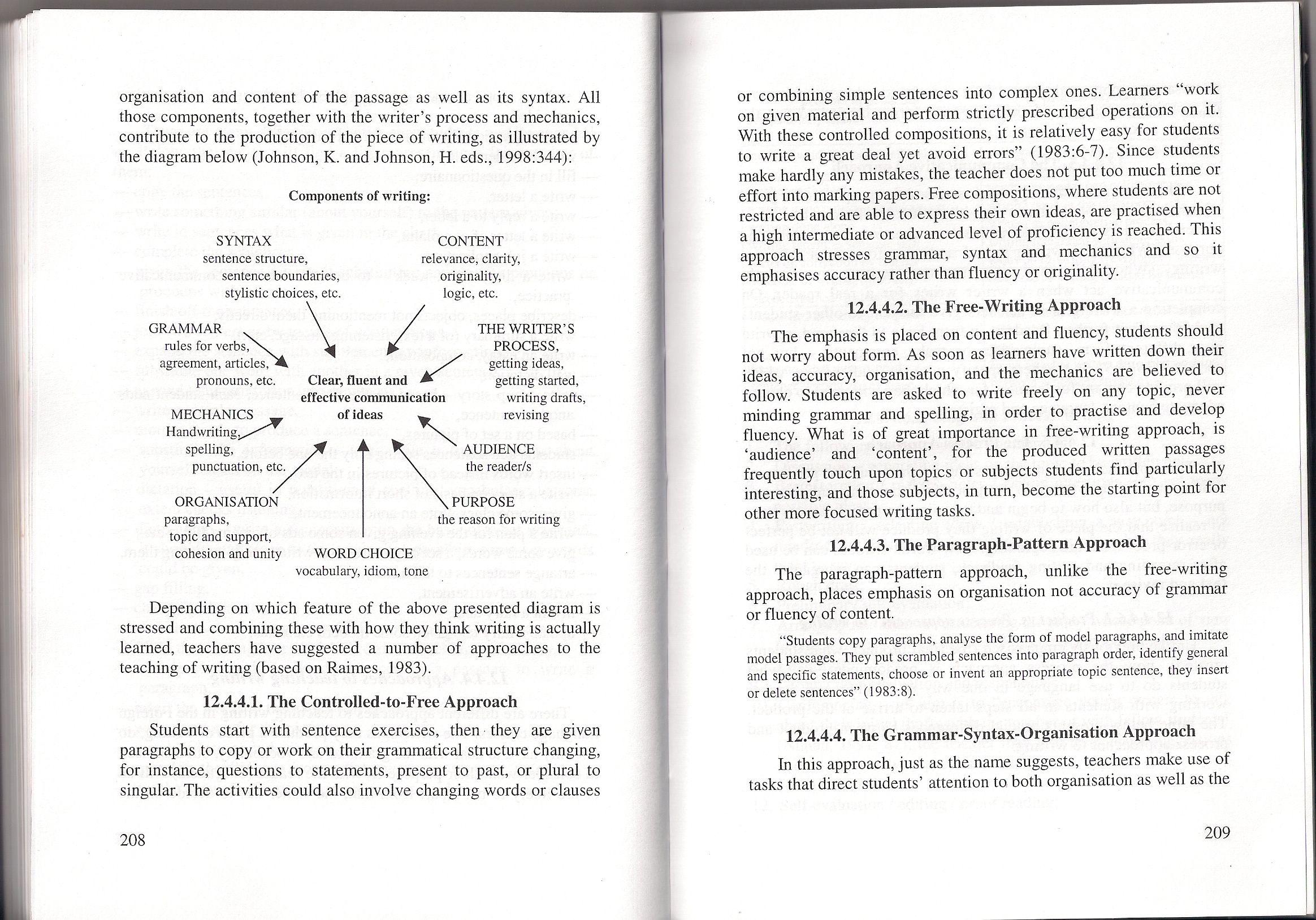skanowanie0104 (2)

organisation and content of the passage as well as its syntax. Ali those components, together with the writer’s process and mechanics, contribute to the production of the piece of writing, as illustrated by the diagram below (Johnson, K. and Johnson, H. eds., 1998:344):
Components of writing:
SYNTAX sentence structure, sentence boundaries, stylistic choices, etc.


Clear, fluent and effectire communication of ideas
CONTENT relevance, elarity, originality, logie, etc.
GRAMMAR rules for verbs agreement, articles. pronouns, etc
MECHANICS Handwriting. spelling, punctuation, etc.
ORGANISATION paragraphs, topie and support, cohesion and unity
WORD CHOICE vocabulary, idiom, tonę
THE WRITER’S PROCESS, getting ideas, getting started, writing draffs, revising
AUDIENCE the reader/s
PURPOSE the reason for writing
Depending on which feature of the above presented diagram is stressed and combining these with how they think writing is actually leamed, teachers have suggested a number of approaches to the teaching of writing (based on Raimes, 1983).
12.4.4.1. The Controlled-to-Free Approach
Students start with sentence exercises, then they are given paragraphs to copy or work on their grammatical structure changing, for instance, ąuestions to statements, present to past, or plural to singular. The activities could also involve changing words or clauses or combining simple sentences into complex ones. Leamers “work on given materiał and perform strictly prescribed operations on it. With these controlled compositions, it is relatively easy for students to write a great deal yet avoid errors” (1983:6-7). Since students make hardly any mistakes, the teacher does not put too much time or effort into marking papers. Free compositions, where students are not restricted and are able to express their own ideas, are practised when a high intermediate or advanced level of proficiency is reached. This approach stresses grammar, syntax and mechanics and so it emphasises accuracy rather than fłuency or originality.
12.4.4.2. The Free-Writing Approach
The emphasis is placed on content and fłuency, students should not worry about form. As soon as leamers have written down their ideas, accuracy, organisation, and the mechanics are believed to follow. Students are asked to write freely on any topie, never minding grammar and spełling, in order to practise and develop fłuency. What is of great importance in free-writing approach, is ‘audience’ and ‘content’, for the produced written passages freąuently touch upon topics or subjects students find particularły interesting, and those subjects, in tum, become the starting point for other morę focused writing tasks.
12.4.4.3. The Paragraph-Pattern Approach
The paragraph-pattem approach, unlike the free-writing approach, places emphasis on organisation not accuracy of grammar or fłuency of content.
“Students copy paragraphs, analyse the form of model paragraphs, and imitate model passages. They put scrambled.sentences into paragraph order, identify generał and specific statements, choose or invent an appropriate topie sentence, they insert or delete sentences” (1983:8).
12.4.4.4. The Grammar-Syntax-Organisation Approach
In this approach, just as the name suggests, teachers make use of tasks that direct students’ attention to both organisation as well as the
209
Wyszukiwarka
Podobne podstrony:
56630 skanowanie0038 (10) The curriculum development or design is the study and development of the g
Training and competence P.T.W systems are only as good as the care and competence of the people who
skanowanie0039 (9) The planning stage consists of all those decisions taken before the development a
skanowanie0048 (9) — model text — culture and background of the
• Preservation and reproduction of the work using techniques such as printing,
6 Contents Katarzyna Kita, Walenty Poczta, Anna Ziemińska: Changes in the level and structure of the
132 Agata Borowska-Pietrzak affective organisational commitment to the goals and values of the organ
Andrzej Urbisz Diversity and distribution of vascular plants as basis for geobotanical regionalisati
• Preservation and reproduction of the work using techniques such as printing,
• Preservation and reproduction of the work using techniques such as printing,
The content of the syllabuses can be easily extended by additional materials such as files or hyperl
skanowanie0048 (9) — model text — culture and background of the
TREŚĆ CONTENTS 107 Reports Current status and perspectives of the Polish book and library science. T
• Preservation and reproduction of the work using techniques such as printing,
więcej podobnych podstron